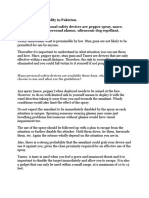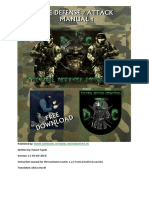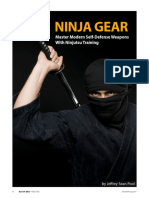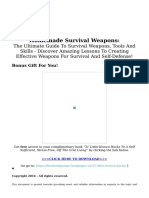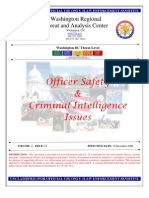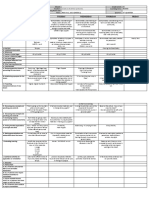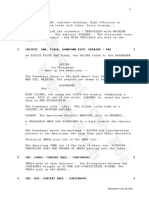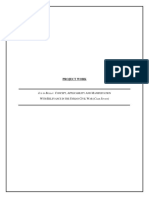Your EDC pocket knife could well be a lifesaving backup weapon during a violent attack.
It can also slice
through a box or spread peanut butter on your sandwich for lunch. As far back as the Stone Age, humans
have survived by utilizing edged weapons. We still rely on them today. Any knife is better than none. In
general, fixed blade knives are more durable than folding knives, but these larger tools may not be a
practical or legal to carry in certain situations. Unless there’s a “concealed weapon” issue to consider, a
small folder is more of a true pocket knife and won’t be trouble to carry in many places—every day. Pick
one that feels good in your hand, with dependable edge retention and sturdy construction. Your life may
depend on it. I know it’s not very “outdoorsy” and it’s an older model, but I love my CRKT Shenanigan.
This is one of Ken Onion’s wicked designs with a grippy diamond texture handle and sharp tanto point
with partial serrations (for sawing, ripping, and general intimidation).
Stun Gun or TASER
The nervous system jolt from a TASER or stun gun can buy you some valuable time to flee. These devices
are designed to incapacitate an assailant with a powerful electric shock, sending signals to the central
nervous system that are both painful and capable of causing severe muscle contractions. These devices
deliver a high voltage (yet low amperage) jolt rather than a deadly bolt of electricity. Most adversaries fall
to the ground with a successful strike. Hand-held stun guns are ideal for close quarters, and the more
“gun-like” Tasers can fire two conductive probes up to 10 yards. These probes emit roughly 19 pulses per
second, with each charge lasting about five seconds. Packing as much as 50,000 volts of power (up to 100
times the voltage of a defibrillator), Taser and stun gun shocks will disable all but the most drug fueled
adversary.
Key Chain Weapons
Individually, house keys and other small items don’t pack much of a punch. Grouped together, however,
these toothy metal items can be used as an improvised flail. Even better, you can add a sharp or weighty
defense tool to your ring of keys as an extra means of protection. This added defense tool could be a spike,
kubaton, monkey fist ball, or any one of a number of other stabbing or striking implements. The best
application for these instruments would be at a time when your keys are in your hand, such as
approaching or leaving your locked vehicle. Should someone lay hands on you, the weapon on your key
chain could be driven into one of those hands, or their face, or an eye, or any other exposed and
vulnerable point. Of all the keychain tools (some of which are very gimmicky) the
original Kubotan developed by Grand Master Takayuki Kubota in the 1970′s is the quintessential “spike
on a keychain” tool for self-defense.
Mace
Fiery hot peppers can do more than just spice up our meals. The story goes that ninjas in Feudal Japan
would use pepper powder to sting the eyes of their opponents and temporarily blind them. Similar stories
from China predate the iconic Japanese ninjas. Jumping forward a few centuries, the idea of a blinding
and burning weapon was reimagined as German chemists devised the first “tear gas” in 1870. Into the
future again, modern pepper spray (also known as oleoresin of capsicum or OC spray) came into common
use in the U.S. in the 1980s. Popularized by its application as a “dog repellent” by the Postal Service
workers, this spicy spray soon spread to the law enforcement realm. Today, companies like Mace and
Saber produce a wide range of OC spray products, each with their own special formula and features. There
can be no debate that pain is a compliance tool, but there is perpetual dispute over the safety and
effectiveness of OC spray. While it has deterred some attackers completely, in other cases, it only enraged
assailants.
Tactical Light
A super-bright flashlight is a complimentary self-defense tool. You’ll want a light that can destroy
someone’s night vision and leave them disoriented for a second or two. You’ll also want a light that can be
used as a weapon during an emergency. This can be a stout and heavy flashlight that can double as a
baton or club. Or it could be a smaller light with a striking edge. Whichever size you choose, you’ll want an
ultra-bright bulb, high powered batteries, a strobe setting (useful for disorienting and nauseating a foe),
and you’ll want it to be easily accessible. Bring the light with you on every trip. I’m still using my SOG
Dark Energy 214, which is several years old but still going strong. This small light has a big output, a
knurled texture for great grip and small square teeth around the lens (as a striking surface and DNA
collector). Newer versions of this light are now available, and there are several variations you can choose.
Just make sure you keep fresh batteries in the light and available for quick replacement.
Tactical Pen
�Tactical pens are items with two different personalities. They perform like any other ink-filled writing
implement, but they are also rugged (and pointy) enough to act as a weapon. Similar to the Kubaton,
tactical pens are sturdy spikes that are easily accessible. These pens can be carried in your shirt pocket, in
your jacket or pants pocket, in a check book, tucked into a briefcase or purse. Carry it just about
anywhere, as long as it’s somewhere handy. Your tactical pen offers little help if it’s buried in the bottom
of a backpack or left at home on your desk. These sharp implements can be driven into the tender parts of
your foe. They can also be ground and twisted into an assailant’s skin to control them (especially when
you successfully target a pressure point). Tactical pens can also inflict shallow puncture wounds. Be
prepared to make multiple strikes, since one brisk poking with a pen will probably not dissuade a serious
attacker. Multiple impacts are your best approach, either stabbing or raking the point repeatedly into your
opponent.
Baton
We get the word baton from the French word meaning stick (so Baton Rouge, the capital of Louisiana,
simply means “red stick”). Solid or fixed batons have a long history of martial use, but they’re hardly
pocket sized. Today’s expandable batons can be easily stored in a pocket, on your belt, in your bag, or kept
handy in your vehicle. Most expandable batons can be deployed in an instant, expanding to anywhere
from 16 to 30 inches in length. Batons can be one of the most reliable tools to protect yourself against a
violent attack. By contrast, one ill-aimed slice with an ordinary pocketknife could lead to a lethal level of
blood loss. While we shouldn’t be too worried about the fates of our adversaries, there is comfort in the
idea of a non-lethal self-defense weapon that can effectively incapacitate a foe without much likelihood of
killing them. Expandable batons can be found in a wide range of styles, sizes, materials and extra features.
EDC Extras
The self-defense tools mentioned here are commonly carried items and could easily fall into the
classification of EDC gear. This grouping of supplies is intended for “Every Day Carry” and it’s not just
weaponry. A Bic lighter is part of my EDC pocket gear, as both a backup light source and a fire starter.
Few things light a fire like another fire, and rather than trusting my fate to a finicky ferrocerium rod, I’d
rather just go with the reliable flame of an everyday carry staple like a Bic lighter. I prefer a brightly
colored lighter, so I can find it in the event that I drop it. I’m also a big fan of carrying a Sharpie. These
trustworthy permanent markers can be vital for signaling and communication. I can write notes and leave
messages on all kinds of surfaces. I can even scribe out my last will and testament on a rock, or write my
SSN on all my limbs (if I’m expecting things to get really bad). But there’s an unexpected terminal use for
markers like this. Light the felt tip with an open flame and the Sharpie will burn like a little candle, for a
minute or two. This could help you get a fire going in wet weather, especially if your lighter is almost out
of fluid or you’re down to your last match. Other popular EDC items include cordage, a first aid kit, a
multi-tool, duct tape, some cash money and your cell phone. Don’t get caught empty handed (or with
empty pockets) when you find yourself in need.
1. Pocket knife
Whether you are a man or woman, the first and most important weapon to invest in is a pocket knife.
Knives are essential and can be used in many ways.
Say, for instance, when out there in the jungle, you can rely on this tool for your survival. Back here
on the streets, the same knife can be used for your protection.
It doesn’t have to be a big knife. You only need a small blade that is easy to use, and that can induce
injuries onto your attackers quickly.
Fighting using a knife isn’t a thing that should be done lightly. It can be useful if you know how to use it in
a fight. So, it would help much if you did some practice.
Remember, when you withdraw the knife, you may trigger your attacker to use any other lethal weapon he
or she may be having, a gun, for example. Therefore, you must be careful when you find yourself
cornered.
2. Pepper spray
If using a knife isn’t your morning cup of tea, then you have got to consider the next option, which is
pepper spray. Pepper spray remains one of the most commonly used non-lethal self-defense tools.
The weapon fires a stream of oleoresin capsicum, spicy oil extracted from hot peppers. Have you cut
pepper while cooking, and then rubbed your eyes accidentally? How was the experience? Of course, it’s
one experience that you wouldn’t imagine.
Now, imagine being sprayed with a stream that is ten times concentrated. Yes, that’s how much pepper
sprays usually are. One good thing about using pepper spray is that it’s instant.
�It hits the eyes, nose, mouth, and lungs, leaving your attacker with no option but to suffer in much pain.
The awful experience can give you ample time to escape or even attack the criminal as he or she can
hardly see you.
3. Stun guns
The high chances are that you have witnessed stun guns at work, either in a movie or a gun show. It
doesn’t matter the setting. The truth is that you can as well own these guns, and drive that electric shock
on your attacker. The electroshock weapons usually use millions of volts of electricity to scare your
attacker.
These guns are typically loud and bright. Therefore, you can even scare away your attacker without using
it on them. After all, no one likes being electrocuted.
When using a stun gun, you shouldn’t be afraid of the many volts, that it may kill your attacker. It can’t
permanently damage them.
Now that you know that you can own a stun gun of your own, you must be considering getting one. The
question is which is the perfect stun gun to get the job done?
Today, the industry is filled with many options, and choosing might prove difficult. Luckily for you, the
experts from https://www.tbotech.com/stun-guns.htm have the hard digging done for you, with a review
of the best stun guns. The guns there are analyzed based on price, size, and even voltage.
By reading the reviews, it will be easy to narrow down your search to that one gadget that matches your
taste and budget. When it comes to using a stun gun, you must have in mind that it must be charged for it
to be effective. Therefore, you must charge it often to avoid disappointments in the moment of need.
4. Flashlights
Fighting using a knife isn’t a thing that should be done lightly. It can be useful if you know how to use it in
a fight. So, it would help much if you did some practice.
Remember, when you withdraw the knife, you may trigger your attacker to use any other lethal weapon he
or she may be having, a gun, for example. Therefore, you must be careful when you find yourself
cornered.
Often, flashlights are used during the night, when you experience a blackout, for example. But, did you
know that the same flashlights can be used as a weapon?
Yes, most flashlights come designed using a heavyweight metal body and are hefty. This makes them a
perfect tool whenever you find yourself in danger. Some flashlights even have a feature that allows you to
blind your attacker momentarily, giving you some time to escape.
When you point a bright flashlight on the attacker’s face, he or she may lose vision. This may give you the
chance to run away for your dear life. Also, there are also some flashlights with a stun gun feature so you
can also look into that.
5. Tactical pen
Who said that for self-defense, you have to carry around heavy objects? Of course, no one. Today, you can
rely upon a tactical pen to deal with your attacker.
Tactical pens are multi-purpose in that they can be used as writing tools and serve as self-defense tools at
the same time. They are usually small and easy to carry around.
Your attacker can hardly notice them as a weapon. Most of them have sharp points to be used to injure an
attacker, while others can be used to deliver a blow.
Self-defense is paramount in the modern world, where the cases of insecurity are on the rise. Listed in this
article are some of the top and easy to use legal weapons that you can use for self-defense.
Read through the article to understand how each tool is useful in the moment of attack. When using these
defense tools, the idea isn’t to win the fight, but to survive.
Therefore, you should stop using the weapon the moment your attacker becomes less of a threat and
escape with the first chance you get.
Pepper Spray: One of the most common tools for self-defense is pepper spray, which is a chemical
inflammatory agent that irritates the nasal passages and eyes of the assailant causing difficulty
breathing, burning pain, and temporary blindness for a short period of time. There are many
different pepper spray formulas such a stream, fogger, foam, or gel. If you are concerned with any
type of blowback from the wind then opt for a gel formula. Some pepper sprays have a UV marking
dye that looks invisible but when under a special UV light can be seen. This can be helpful when
identifying an attacker. Pepper spray is a great portable option that comes in a variety of styles and
holster options. You can find pepper spray disguised as a lipstick , a pen , or even a gun. You can also
buy key chain holsters or handsleeves to use while running or walking outside. It's a simple non-
lethal option that can be used against an attacker, stray dog, or even a drunk guy at a bar.
�Stun Gun: A stun gun is a non-lethal device that delivers a high-voltage electric shock to an
attacker. They are designed to transfer high-voltage shock into the nervous system causing
disorientation, loss of balance, and possibly difficulty moving. Stun guns require direct contact with
a person so the electrodes can deliver the shock which means an attacker will need to be within arms
reach. Besides the standard looking stun gun, they also come in disguisable forms such as a faux cell
phone , flashlight , and even a cell phone case that fits over your real cell phone .
TASER: A TASER is similar to a stun gun in that it delivers a type of shock. However, the TASER
brand delivers 50,000 volts which causes an attacker's muscles to lock-up, which temporarily
immobilizes them. Additionally, the TASER can be shot from a distance (up to 15 ft) so you don't
need to be in close range. The TASER shoots out two electrodes that can penetrate clothing and skin.
Once in contact with the attacker it delivers an electric shock to the muscular system to immobilize
them. There aren't many discreet options for tasers but having your potential attacker see a gun-
shaped object (even if it's a TASER) might be enough of a deterrent. You can read more about my
thoughts on the TASER Pulse here.
Tactical Flashlight: If you think that a flashlight can't help you in a threatening situation then you
don't have a tactical flashlight . Tactical flashlights have brighter and stronger beams of light
(lumens) and come with a jagged/spiked bezel around the lens and heel. Not only will the tactical
flashlight brighten up dark alleys or areas, the bezel can be used to strike an attacker while the
bright beam of light works great to temporarily blind them.
Knives, Tactical Pens, and Striking/Stabbing Tools: While some of these sharp objects can be
lethal if used properly, they are a good alternative to a firearm, and a self-defense option that should
be considered. I have a few in my arsenal (pocket knife , tactical pen/multi-tool , tactikey , and
kubotans which are handheld or knuckle style striking tools) that I like to carry around with me.
However, since these items are all smaller fist-held tools they require close proximity and skill to be
effective. Having some training and understanding how to use these tools for personal defense are
key to ensuring your safety. There are places nowadays that offer hand-tool fighting classes like
knife-fighting classes.
Personal Alarms & GPS Devices: While personal alarm devices won't do anything to
incapacitate an attacker, they will draw attention to you and might have the attacker think twice.
There are two types of personal alarms available. The kind that sound-off an alarm and ones that
send your GPS location to a set of contacts and/or alert authorities. The alarm-sounding devices
emit a loud ear-piercing alarm (up to 100db+) that help to draw attention to yourself and any
possible situation. These devices come in the form of cell phone apps , specific hand-held button
tools , and some even disguised as lipstick .
TigerLight D.A.D. 2: The Defense Alert Device (DAD) is a pepper spray, multi-mode flashlight,
striking tool, and an alert/GPS device all-in-one. It was designed to be carried in your hand with
simple controls to be used under stress—one button for the pepper spray/GPS, and another button
for the flashlight. One of the key features is that the D.A.D. 2 does not look like a weapon. With the
hand strap, the D.A.D. 2 looks like it could be something as simple as a water bottle when out on a
run and the strap keeps the device where you need it to be in your hand. A simple push of a button
activates the GPS alert through the D.A.D mobile app so a distress alert is sent out to your contacts,
as well as anyone else nearby with the app, that you need help. This is a durable, lightweight, and
discreet option. The D.A.D. 2 also comes in a non-pepper spray model.
Physical Defense: A final non-lethal self-defense tool to consider are physical self-defense
classes. While all these tools are great options for buying you some time to flee from your attacker,
one area that is often overlooked is your personal fitness. While you don't need to be winning gold in
the sprint, being physically fit will help you when it comes time to defend yourself. There are many
self-defense classes for women that teach you how to defend yourself using your own body. While
you don't have to take a specific self-defense class, adding a new physical fitness skill to your routine
such as boxing, Muay Thai, or Krav Maga are all great options that teach some form of fighting
techniques that you can draw upon should you need.
Be Aware: A good personal defense plan starts with situational awareness. It's important to
be aware so that you can avoid and prevent a situation from happening. Ensure you are
paying attention to your surroundings, how people are behaving, and determine if things
seem out of place. By being aware of your surroundings, you'll hopefully be able to prevent
an attack from happening.
Know Your Tool/Device: Owning the tool is a step in the right direction but without the
proper training and skill to effectively use the tool in a self-defense situation makes it
ineffective. As mentioned, there are plenty of videos on YouTube that demonstrate different
� techniques for properly using many of these tools. Check them out and practice with your
spouse or a friend. Just remember to use a prop in place of the real tool.
Easily Accessible: If the tool you choose isn't easily accessible then it's basically useless.
Find places on your body, in your hand, or in your pockets, where you can carry the tool so
you can easily get to it should you need to. Depending on where you decide to carry it, you
should also practice drawing your tool from that location.


